




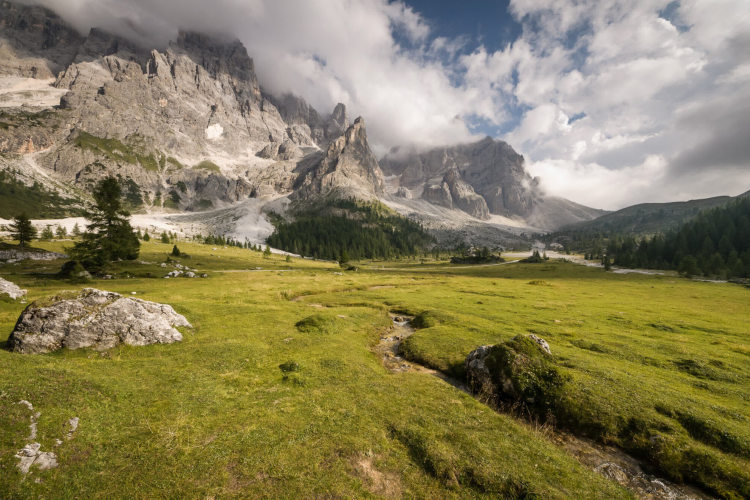






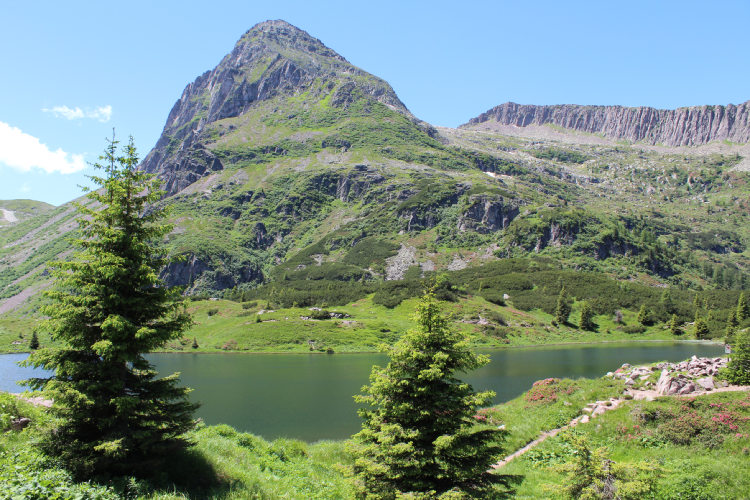

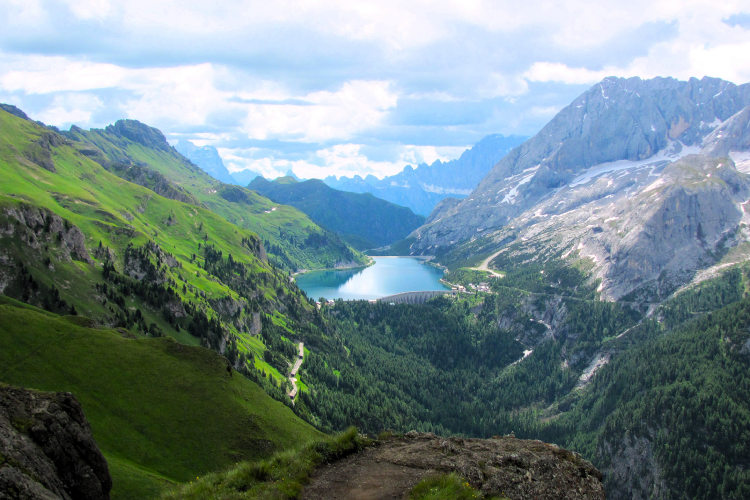

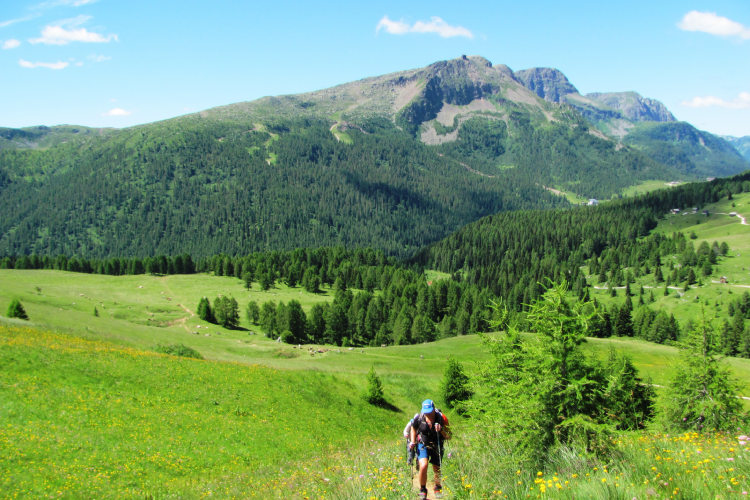
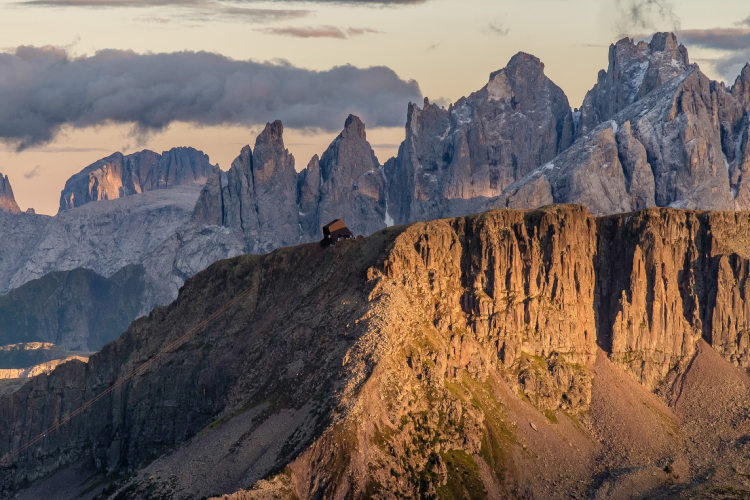
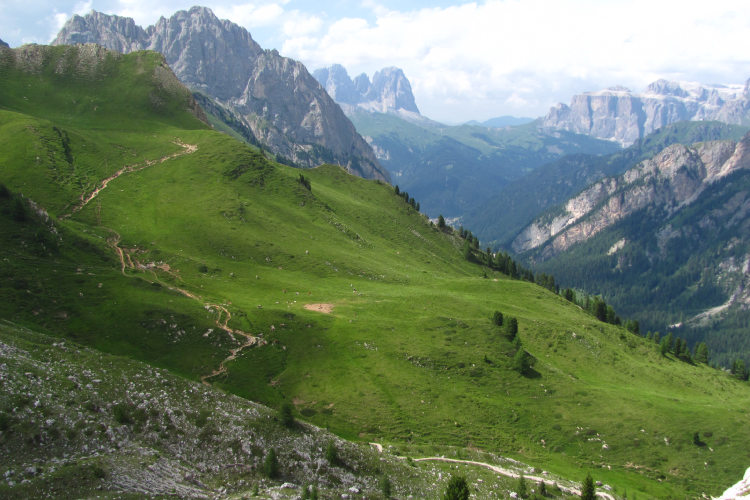

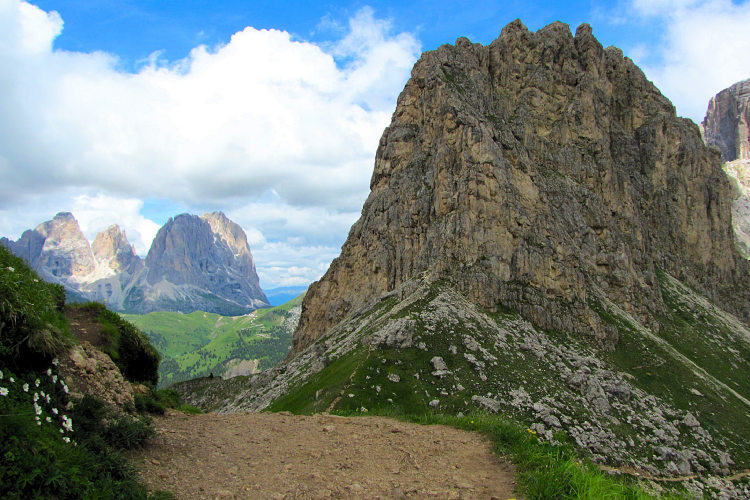
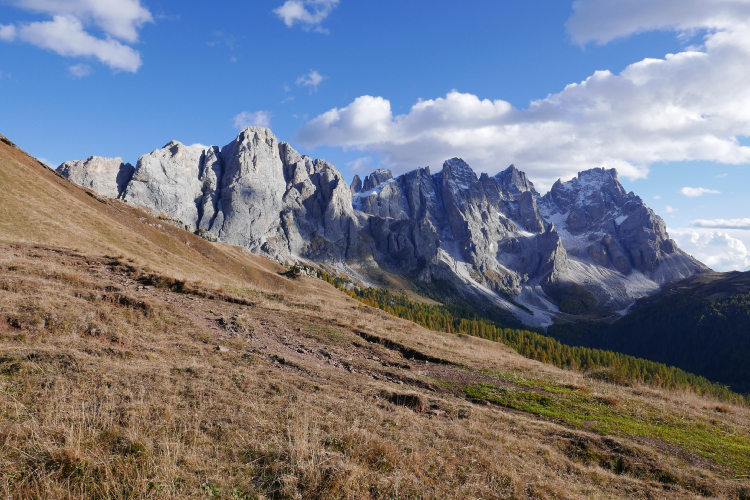
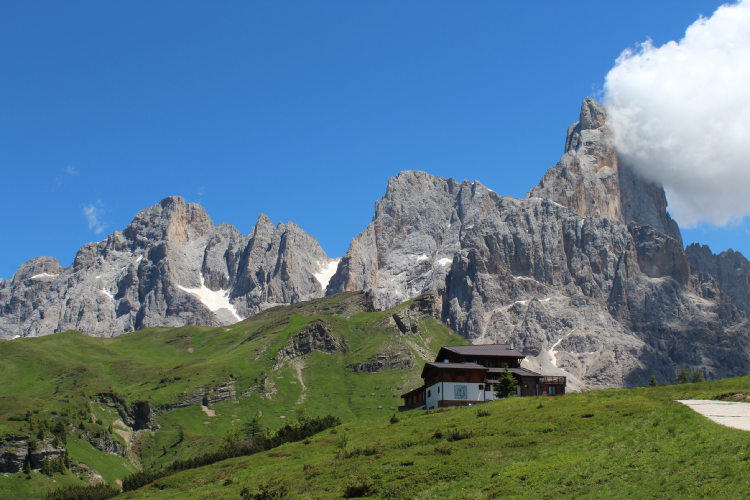



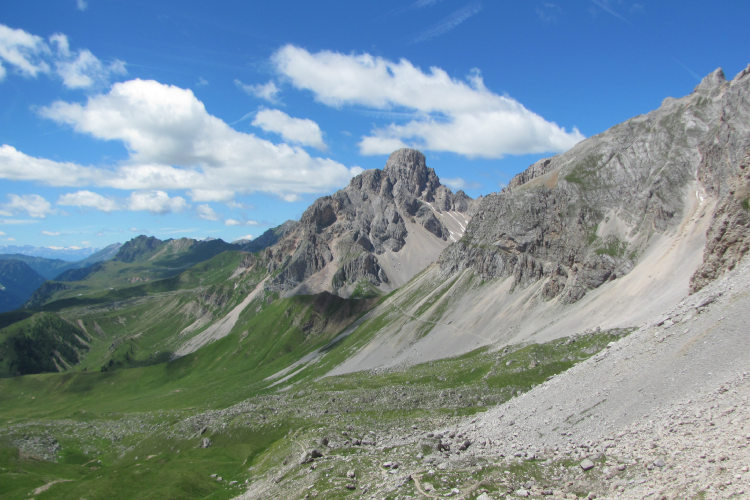
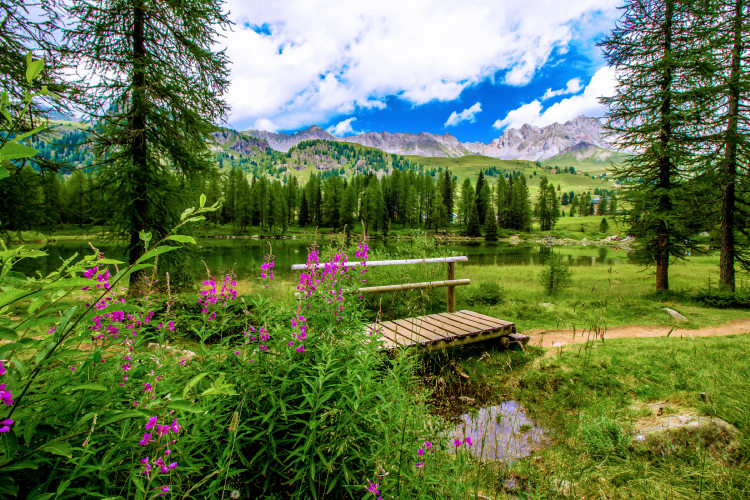




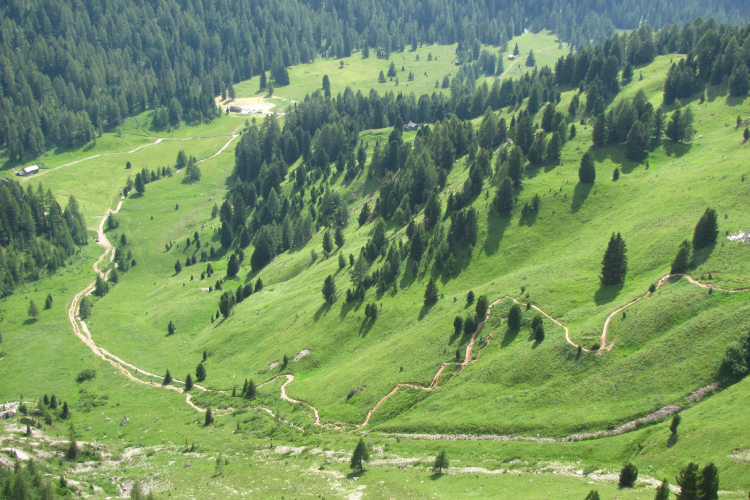
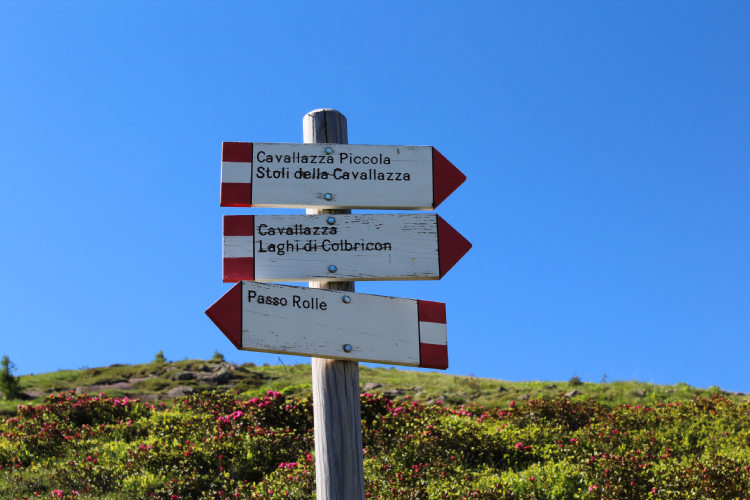
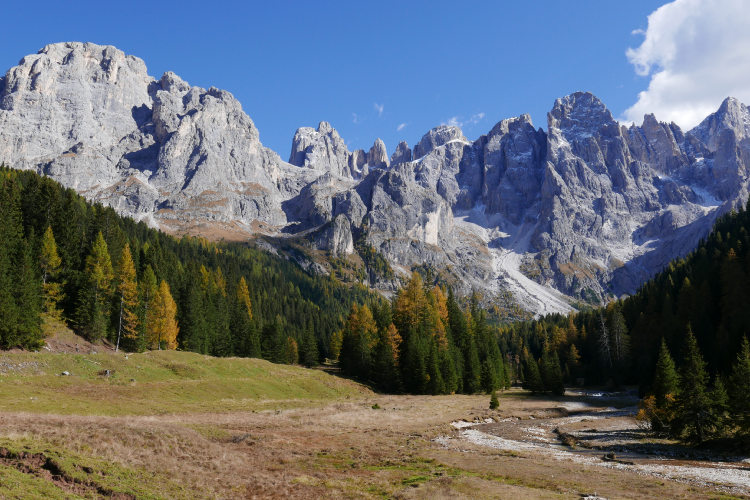

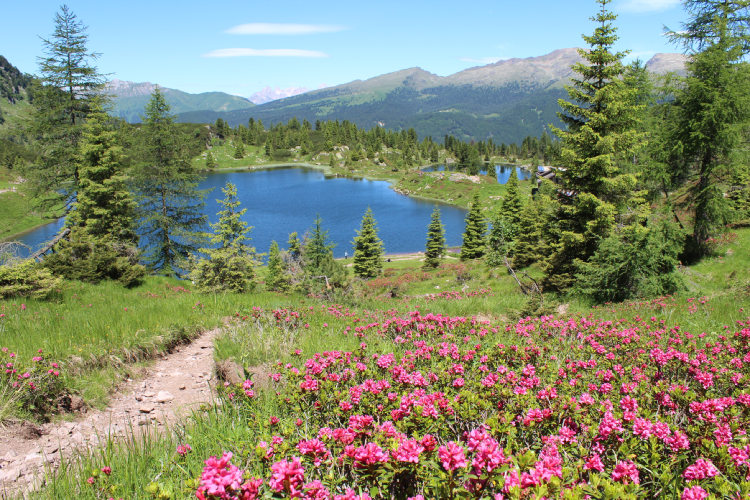
Home/Dolomites Hiking Tours/Trek of the Legends
Moderate daytime distances, mostly on easy trails
Pale di San Martino, Monzoni, Marmolada, Sella
Diverse landscapes, iconic landmarks, postcard-perfect views
Low "trail traffic" on most of the route, true mountain experience
Region with a rich history and culture, long traditions of hospitality
This itinerary and hiking schedule are designed for hikers who prefer relatively easy treks with moderate daytime distances. Another aspect you will enjoy about this route is the lack of significant numbers of tourists on the trails. Even though the route passes through well-known and picturesque mountains, there is relatively low “trail traffic”. The Trek of the Legends is a way to immerse yourself in the magic and beauty of the Dolomites, hiking along little-known trails through places of great natural and historical value. It is a relatively new hut-to-hut hiking route. It was first described in 2004 by a group of locals who wanted to plan a multi-day trekking adventure that would connect their homelands – Val di Fassa, Val di Fiemme and San Martino di Castrozza. Their route was later named the Trekking of the Legends, because this area of the Dolomites is the source of many fairy tales and legends. Regional folklore tells that magical animals, funny gnomes and kind bearded men live in the forests here, and that secret paths lead to the impregnable palaces of great kings. Once upon a time, a small red-clad elf, the so-called "Salvanel" llived in these forests. Legends say that Salvanel hid in the woods to play tricks on travelers passing through the Dolomites. Today, Salvanel and other characters from folk tales come to life in wooden sculptures that you can see in San Martino, Val di Fassa and sometimes near mountain huts and farm steads along the route.
The itinerary follows the classic 2004 Trek of the Legends where the trail is not too challenging for a Level 2 route. It bypasses via Ferrata and the most difficult passes. The route rather runs along some of the less-known trails connecting the Pale di San Martino Group and the upper Val di Fassa. Quiet trails, pristine nature and remote mountains are among the major highlights of this itinerary. Despite running off the beaten track, this itinerary reaches such the landmarks of the Dolomites as Pale di San Martino, Monzoni, Marmolada and Sella Group.
The trek will take you through an impressive variety of landscapes. You will hike through dense spruce and larch forests, cross alpine meadows above the tree line, reach pristine crystal-clear lakes, and explore rugged lifeless high-altitude terrains. The trek starts in the historical town of San Martino di Castrozza, from where you will head to the Paneveggio Nature Park, a large oasis of untouched nature with relict coniferous forests and quiet isolated lakes. Leaving Paneveggio, you can see a remarkable geological contrast at Passo Rolle, where the volcanic formations of the Lagorai Group meet the limestone of the Dolomites. At Passo Rolle, you can admire one of the most scenic views of the Dolomites – the west face of Pale di San Martino with its most photographed peak Cimon della Pala. The route then continues at an average altitude of 2000–2200 meters to Passo San Pellegrino. These places preserve many testimonies of the First World War, when the pass was the front line. San Pellegrino Pass is also the gateway to the sunny Val di Fassa and the charming Fassa Dolomites, where the first mountain group on your route will be the Monzoni. The trek culminates at the Pas de Ombreta pass separating the groups of Monzoni and Marmolada. You will cross the pass at the base of the impressive 1000-meter-high south face of Marmolada, "The Queen of the Dolomites". Beyond Marmolada, you can finish the trek in the enchanted Val San Nicolò valley, a unique corner of the Dolomites where time stopped 200 years ago, leaving it unchanged since then. The longer route options let you continue the trek toward another Dolomites landmark, the Sella Group.
The base camp locations for this trek are San Martino di Castrozza and Val di Fassa, where you will stay overnight on the first and the final nights of the trip. We take care of your excess luggage and transport it from your hotel San Martino to Val di Fassa while you are in the mountains. There are several route options varying primarily in length. The main route requires 6 days of hiking with 5 nights in comfortable mountain huts. For the hikers seeking to venture further and discover even more of the Dolomites, there are route options with 7 and 8 full hiking days options that allow you to reach the Sella Group or explore the Pale di San Martino Plateau or do both. You can decide to go hiking with a mountain guide or to enjoy the solitude on a self-guided trip. The guided trek offers the opportunity to discover some of the secret corners and learn about the history and culture of this region, but otherwise the itinerary is perfectly doable and enjoyable for self-guided hiking using our instructions and schedule for self-guided hikers.
In terms of difficulty, this is a normal Level 2 trek, which follows regular hiking trails, trodden and well-marked. The day crossings require 3-5 hours of pure walking time, which leaves plenty of time for interesting detours and to enjoy the Dolomite scenery without feeling pressed for time. While prior experience of hiking in the Dolomites is not necessary, a reasonable level of fitness is required. The most demanding section of the itinerary is the continuous ascent to Pas de Ombreta with an altitude gain of 630 meters, steep in its upper part, where the terrain is uneven and rocky. If you choose a self-guided trip, you must be able to read the hiking maps and navigate independently on the itinerary, which is accompanied by our detailed directions and instructions.
Many of the mountain huts along the route are among the most comfortable in the Dolomites. Some of them fit the category of a mountain inn rather than a refuge. To ensure the best accommodation, we recommend booking your trip as early as possible, as everywhere in the Dolomites.
StyleHut to Hut Hiking
Tour Duration7 - 10 days / 6 - 9 nights
Start / FinishSan Martino di Castrozza / Val di Fassa
Validity of prices: Summer 2026.
Private guided tour: the price is based on a minimum of 4 participants.
Private guided and self-guided tours are private tours on the dates of your choice.
See tab Prices for minimum and maximum group size, included services, single supplements and other details.
Day 1: Arrival in San Martino di CastrozzaToday, you arrive on your own in San Martino di Castrozza. This small resort town at the foot of the Pale di San Martino Group is the ideal base camp location for several of our hut-to-hut treks. San Martino is located in eastern Trentino but is easier accessible from Venice, where there is a large international airport. It is renowned for breathtaking views of Pale di San Martino. In addition to its natural beauty, the town is known for the traditional Alpine architecture with a slight Venezian touch. There are long traditions of tourism and alpinism in San Martino, dating back to the mid-19th century. At that time, San Martino became a base for pioneering climbers from England and the Austro-Hungarian Empire and a holiday destination for the European aristocracy. A summer evening in San Martino is a wonderful start to a hiking holiday in the Dolomites. Right from the streets of San Martino you can see the chain of peaks of the Pale Group, painted in a wide range of bright colours by the rays of the setting sun against the backdrop of the fading sky. |
Day 2: Paneveggio Nature ParkAscent 770 m. Descent 150 m. Distance 10 km. Altitude 1450 – 1930 m. Walking time 4 hours. It is time to begin your hut-to-hut hiking adventure in the Dolomites. The classic Trekking of the Legends itinerary starts in the pristine Paneveggio Pale di San Martino Natural Park. Established as a protected area in 1967, the park is characterized by an extraordinary variety of natural environments. Spruce forests, towering rock walls, alpine meadows, lively streams, tranquil lakes and rich wildlife are just some of its treasures. The three iconic symbols of the park are the imposing Dolomite peaks of Pale di San Martino, the dark porphyry of the Lagorai Group and the relict coniferous forests of Paneveggio. Leaving the town of San Martino, a forest road leads you into the heart of Paneveggio, marking the beginning of your trek. First, you go deeper into Lagorai along a gently ascending trail surrounded by a dense forest of larches and fir trees. Passing a traditional alpine dairy farm Malga Ces, set among mountain pastures, you soon reach the Passo Colbricon pass at 1908 meters. The pass is just above the tree line, so this is where you will start to get a feel for the high mountain before you descend to the Colbricon Lakes. The glacial sparkling waters of these lakes, surrounded by majestic mountains, create an unforgettable setting. Hidden from the noise and winds, this place is ideal for a short stop before continuing to Passo Rolle, where you will stay overnight. The further path to Passo Rolle is an excursion into the geological history of our planet. Two very different types of rock meet here in a spectacular contrast. On one side, there are the volcanic formations composed of quartz porphyries of the Lagorai Group. On the other side, you will see the majestic peaks of Pale di San Martino formed from sedimentary carbonate rock also known as Dolomite. At the end of the day, a mountain hut awaits you at Passo Rolle where you can relax after a day filled with natural beauty and adventure. |
Day 3: Passo Rolle and Val VenegiaAscent 440 m. Descent 480 m. Distance 8 km. Altitude 1880 – 2220 m. Walking time 3 hours. Today's hike is shorter and easier than yesterday, allowing you to take a couple of detours to the local peaks for stunning views. We recommend starting your day with a rewarding climb from your hut to Monte Castellaz. North of Passo Rolle, there is a vast plateau with several elevations. Monte Castellaz is one of these elevations, notable for a majestic 360-degree panorama spanning the Pale di San Martino. If you get up very early, you can even watch the sunrise over the Pale peaks when the Dolomites glow a bright red and sun slowly illuminates the rocks. The landscape of the plateau to the north of Passo Rolle is mainly meadows with occasional conifers. Crossing the plateau, you follow a picturesque, well-trodden trail. It is a pleasant hike in the most natural scenery and without any stress or rush because the daytime trek ahead is moderate in length. Before you start descending from the plateau, you can enjoy one of the most celebrated views of the Dolomites: the majestic Cimon della Pala, the second highest peak of Pale di San Martino and its calling card. Often referred to as the "Matterhorn of the Dolomites”, this peak rises to 3184 meters and is a favorite landmark for hikers and climbers. Leaving behind this postcard-like landscape, the trail continues through the coniferous forests of the upper Val Venegia valley. Centuries ago, logs cut from these forests were destined for the worksites of the Venetian Republic. The name of the valley reminds us of this fact - "Venegia" derives from "Venezia". Through the forest, you will ascend to a saddle, from where you will have the opportunity to climb to a local peak, Cima Valles. This isolated peak offers an expansive view of the surrounding mountains. The Passo Valles area is also visible from the peak. It is just 30 minutes away. The meadows and sparse forests around Passo Valles are known for the rich wildlife, including chamois, ibex, and marmots. You will almost certainly hear the warning whistle of marmots as you descend to the pass. And if you are really lucky, you will catch sight of chamois climbing the rocks of the Dolomites. |
Day 4: Col MargheritaAscent 280 m. Descent 330 m. Distance 10 km. Altitude 1920 – 2230 m. Walking time 3 hours. This daytime trek is a relatively easy yet rewarding crossing from the edge of Pale di San Martino to the majestic Fassa Dolomites. These giant mountain regions are divided by the Col Margherita ridge and Passo San Pellegrino pass. From Passo Valles, the trail slowly ascends Col Margherita. You will traverse verdant meadows painted with thousands of colorful flowers. Until mid-July, rhododendrons bloom here, making the landscape incredibly lively. The south slopes of Col Margherita still let you see behind you Mulaz, Focobon, Vezzana, Cimon della Pala and other numerous peaks of Pale di San Martino. At the Forcella di Pradazzo saddle, you will have a choice to proceed directly to Passo San Pellegrino or deviate from the route to climb the crest of the Col Margherita ridge. There is a trail along the crest from which you can see the Monzoni Group rising opposite and the more distant mountain groups surrounding Val di Fassa. This impressive view will accompany you as you descend along the slopes of Pale del Cargol, a natural balcony overlooking Passo San Pellegrino. The trail starts descending through small clearings, gradually entering a sparse forest of Swiss pine and larch trees before reaching the pass. In the past, the pass at an altitude of 2000 meters was the site of fierce battles during World War I, where Italian and Austro-Hungarian forces clashed. Today, remnants of this tumultuous past remain, with visible trenches, bunkers, and fortifications scattered throughout the area. Nowadays, the pass is a vital communication route between the regions of Trentino and Veneto. Beyond the San Pellegrino Pass you will find yourself in what is probably the most picturesque landscape of today's hike. You will pass through a sparse coniferous forest and continue along the meadows covering very gentle slopes, bordered by the countless peaks of the Monzoni Group. You will finish the day in this scenic location and stay overnight at a cozy mountain hut, renowned for its warm hospitality, exceptional cuisine and the stunning beauty of the surrounding landscape. |
Day 5: South Face of MarmoladaAscent 860 m. Descent 770 m. Distance 11 km. Altitude 1630 – 2490 m. Walking time 5 hours. You will hike towards Marmolada today and reach its impressive south face, which is a blend of natural beauty, challenge, and historical significance, making it an unmissable destination for mountain lovers. Your daytime trek starts with a non-fatiguing crossing of the picturesque Fuciade meadows followed by a gentle climb up the slope of an open grassy ridge. As you hike through the pastures, your trail will merge with the Alta Via dei Pastori, a route making part of the vast network of trails that cross the Dolomites. This route links alpine dairy farms and mountain huts in the areas with deep roots in the pastoral traditions. This route is a reminder that in the past, mountain trails were of great practical importance in the economic activities of the population of the Dolomites. You will follow Alta Via dei Pastori until Forca Rossa at 2490 meters. The name translates as “red saddle” and refers to the reddish color of the rock on the upper slopes. Forca Rossa will reward you with a stunning view of the mountains to the east of the Monzoni Group which were not visible on the route earlier. On the opposite slope of the saddle there was once a scree, but now it is a solid slope along which your path zigzags down. Although steep in its upper part, the descent is not technically difficult. It requires careful attention, especially on the sections of trail that pass through rocky terrain. Further along your itinerary, the terrain alternates between grassy stretches and rocky patches until you reach the pastures and forests of the Val di Franzedaz hollow, which links you itinerary to the trail that bypasses Marmolada at the base of its south face. Marmolada is crowned by the highest peak of the Dolomites, the 3343-meter-high Punta Penia. Marmolada is also home to the only surviving glacier of the Dolomites. The locals historically call Marmolada the Queen of the Dolomites. You will have the honor of hiking at the foot of the Marmolada and enjoying views of unsurpassed beauty. Your trail skirts the south face, which does not feature glaciers but instead presents a massive, vertical wall that soars dramatically towards the sky. This sheer wall is a renowned landmark of the Dolomites and a magnet for climbing enthusiasts. The trail you will follow at the foot of Marmolada is one of the most beautiful and sought-after routes in the Dolomites. You will reach your mountain hut. |
Day 6: Pas de OmbretaAscent 640 m. Descent 690 m. Distance 6 km. Altitude 2010 – 2730 m. Walking time 4 hours. There is no better way to start this day than a hearty breakfast because today you will be hiking along the most challenging trail of your itinerary. Neither the route is too long, nor the elevation change is too great, but you will reach higher altitudes, where the terrain radically differs from the welcoming landscapes you have been accustomed to so far. From the hut, the trail rises steeply towards Pas de Ombreta, the highest pass on your itinerary. This route was once an important communication link during the First World War. Remnants of trenches can still be seen, bearing witness to the harsh mountain warfare. Once you leave the hut, you will very soon find yourself on a grassy slope above the tree line. As you ascend, you will undoubtedly appreciate the view of the imposing Sasso di Ombretta, one of the most recognizable peaks in the area. At higher altitude, the terrain becomes rockier and more barren, the slope becomes steeper, the vegetation thins out. The surface is uneven, but the trail is not technically difficult with just a few gravel sections where you need to maintain a steady step. The characteristic rocky forms of the Dolomites accompany you all the way up to the Pas de Ombreta at 2727 meters. The pass offers spectacular views to the west across Val di Fassa, where the Rosengarten group is clearly visible. The descent from the pass is not particularly steep or exposed but long and scenic. You will descend along a zigzag path down a slope partially covered with small and medium fractions of rocky debris. As you descend, the landscape will slowly give way to lush green meadows and sparse spruce forest. The descent ends at the door of your mountain hut in a picturesque location at the foot of the Marmolada. This area is steeped in legends, and their main character is the little princess Ombretta. To understand why this area was so attractive to folk storytellers, it is enough to leave the mountain hut for 5 minutes in the dark late at night and see the peaks of Monzini in the moonlight. |
Day 7: Val San NicolòAscent 380 m. Descent 670 m. Distance 9 km. Altitude 1690 – 2340 m. Walking time 4 hours. The trek ends with a pleasant and scenic crossing from the upper Val Contrin to Val San Nicolò. You will head toward Passo San Nicolò, a charming mountain pass connecting the two valleys. Passo San Nicolò is actually a barely distinguishable saddle on a wide and relatively flat ridge that branches off from the local peak, Col Ombert. The gradual slopes of the ridge are grassy. As you approach the ridge, you will cross expansive meadows that lie at its base. Once at the pass, you will be rewarded with a magnificent panoramic view dominated by the Sella Group, previously not visible from the route. The local landmark you will see in front of you is "Denti di San Nicolò", a chain of the Monzoni peaks towering against the sky. From Passo San Nicolò, your route descends to Val San Nicolò, one of the most picturesque valleys in the region. With its idyllic pastures and characteristic mountain landscape, Val San Nicolò has remained largely unchanged over the years. Lush green meadows, grazing cows, small wooden huts, and the peaks of Monzoni soaring against the blue sky altogether create a scene of timeless beauty. Val San Nicolò is also steeped in local legends and fairy tales, the most famous of which tells of a deer "Cervo di San Nicolò" that guided shepherds to safer lands. As you walk through the valley, you will notice old farm steads that illustrate the traditional rural life in the Dolomites. These wooden buildings are still in use as hay storage. After a relaxing hike through Val San Nicolò, your trek will end at the bottom of the valley, where the road from Val di Fassa approaches. |
Day 8: DepartureThis adventure has come to an end. At your base camp hotel in Val di Fassa, you will be offered breakfast, and then you can head home or to your next holiday destination. On this trek, you reached some of the most impressive landmarks of the Dolomites, hiking along relatively easy trails off the beaten track and at a moderate pace. It is one of very few long hut-to-hut itineraries in the Dolomites where relatively short crossings between all mountain huts are possible, and where the terrain is not too rugged and the trails are not too difficult. |
Shortened itinerary with a start at Passo Rolle The itinerary of the 7-day tour starts at Passo Rolle (Day 3 of the main itinerary). It bypasses the ascent from San Martino to Passo del Colbricon and the crossing to the Colbricon lakes. Optionally, you can decide to hike to the Colbricon lakes from Passo Rolle, but it requires a detour of 2-3 hours. |
This route continues beyond Marmolada and reaches the Sella Group The 9-day tour includes 5 days of hiking along the main itinerary from San Martino to Marmolada and then 2 days of hiking to Passo Fedaia and then the Passo Pordoi. You will finish this trek at the foot of the Sella Group. Instead of descending to Val San Nicolò on Day 7 of the main itinerary, you will go around the Marmolada Group from the west and reach Lake Fedaia under the northern slope of Marmolada. From Lake Fedaia, you will continue along the scenic Viel dal Pan trail, from where you can observe the Marmolada glacier. Having reached Passo Pordoi, you can optionally take the cable lift up to the Sella Group. The immediate surroundings of the Sella plateau offer a vast panorama of the Dolomites to the east, south and west and a stunning view of the Sassolungo group opposite. Once back at Passo Pordoi, you can take another cable lift down to Val di Fassa and finish the trek. |
The complete itinerary from San Martino to Sella Group and a day hike on the Pale Plateau If you have an extra day to enjoy the Dolomites, we recommend planning a day hike on the Pale di San Martino Plateau. The Pale Plateau will be your first day of hiking, which you can do light, leaving your backpack at the base camp hotel in San Martino, where you will stay for the first two nights. To reach the plateau and then return to San Martino, you will take a cable lift directly from the town. The plateau is a unique high-altitude landscape, lush and lifeless. It is usually called lunar. There are two easily accessible peaks on the plateau which you can ascend for expansive panoramas while exploring the plateau. |
Validity of prices: Summer 2026.
The prices are per person and include the VAT tax.
Private guided and self-guided treks are private tours on the dates of your choice.
The indicated tour duration includes the days of arrival and departure. Hotel accommodation on the day of arrival and night before departure is included in the price.
Self-guided tour. Supplement for trips for solo hikers:
7 Day Self Guided Tour | Solo supplement € 160
8 Day Self Guided Tour | Solo supplement € 160
9 Day Self Guided Tour | Solo supplement € 160
10 Day Self Guided Tour | Solo supplement € 220
Private guided tours are only open to your group. The price listed on the tour page is for groups of 4 members. You can set a larger or a smaller group – please contact us for a price.
Proper hiking boots are a must for the mountains. We recommend high boots because they support the ankle better than any low boots and provide better stability on a rocky terrain. Even in the middle of the summer in the Dolomites you must bring some warm clothes with you: waterproof and windproof jacket, fleece jacket, long trekking pants and a cap. A raincoat, poncho or other type of rainwear is necessary. Other necessary items are the toiletries, light clean footwear to use in the huts, sunglasses and at least 2 one-liter bottles for water. Your trip documents will include a detailed packing list specifically prepared for your itinerary. We kindly ask everyone to read it carefully and be properly prepared for the hiking trip.
The first and last nights of your trip are in one of our basecamp hotels. While hiking, you will stay overnight in the mountain huts. You can count on the following services in the mountain huts: a bed in a shared room or in a private room (must be booked in advance), shower with hot water, toilets, meals, and a possibility to buy take away water and snacks such as sandwiches and chocolate. Shared rooms are equipped with bunk beds with mattresses, pillows and blankets. Bed linen is not provided in shared bedrooms: you must have a sleeping bag liner with you. Typically, it is a light cotton bag. Warm sleeping bag is unnecessary, since there are blankets in the bedrooms. In private rooms you are often offered bed linen, thus a sleeping bag liner is not required. If you book private rooms, we inform you on whether you need to bring a sleeping bag liner. Most huts have a heating system, but it is normally not required in the summer months. You will need clean footwear for the huts: light slides are an ideal solution. For detailed information on the huts please read Mountain Huts in the Alps.
The trek starts in San Martino di Castrozza a small town best connected to the Venice airport. There is a daily bus connection with the airport in July and August, while in June and September the direct bus connection is only available in weekends. A trip to the Venice airport takes between 3h 30m and 4h. Travel to other airports is less convenient and takes longer: Verona, Bergamo, Bologna.
The ending point of the trek is Val di Fassa. Verona is the closest airport, there are regular flights from the UK, Germany, Denmark, France and Poland. It takes around 4 hours to arrive by train and bus from the Verona airport to the Fassa valley. Other airports: Munich, Innsbruck, Venice, Bergamo, Bologna, Milan.
We can help you plan the logistics and provide you with train and bus schedules: please contact us before you buy the plane tickets.
In hut-to-hut hiking tours you are served a breakfast and a dinner in the huts and mountain hotels on the route.
Normally, the breakfast is served from 7am to 9am. It usually includes an unlimited quantity of coffee and tea, bread, butter, jam, honey and chocolate spread. In addition, some huts offer ham, cheese and muesli for breakfast. After breakfast we recommend filling your thermos with hot water or tea: ask the staff, and it will be for free in most huts.
The dinner time in the mountain huts is 7pm or 7:30pm for all guests. A typical dinner in a hut is very rich and includes a starter, the first course (such as pasta, risotto, dumplings), the second course (meat with a side dish) and a dessert. Any drinks at dinner (water, wine, beer, tea, coffee) are not free and should be ordered and paid separately.
Lunch. It is possible to stop for lunch in the mountain huts on the route on most days of the hike. The lunch menu in the huts is similar to the dinner menu. Typically, there is a choice of pasta for 10 – 15 euros. Second dishes cost 15 – 20 euros.
Our guided hiking tours are led by professional guides, each with years of guiding and wilderness experience and with passion for mountains. They permanently work in the region of the exact hiking tour, have professional licenses, are experts in emergency situations, regularly upgrade their qualifications and work in accordance with national regulations.
For self-guided hiking, it is necessary to be properly dressed, follow the safety rules and make realistic time calculation for day crossings – preferably according to the hiking schedule that we provide. Our self-guided hiking trips are planned so that they do not require specific skills or gear, unless it is clearly specified in the tour description. You can expect well-maintained trails equipped with direction signs. Exposed sections of the trail are secured on the self-guided routes: it makes them safe provided that you follow the basic safety rules for hiking in the mountains.
Mountains are a natural environment with a high level of risk, so we insistently ask all participants to read the safety rules and emergency procedures: Safety Considerations. If you have questions about the safety rules, please contact us +39 0463 63 60 80.
Insurance. It is important to have an appropriate insurance that covers the hiking activity. You don't need to include the climbing activity in your insurance, unless you are planning to climb during the hike.
Visa. We will provide you with a booking confirmation for all days of your trip. If you need the Italian visa, you can enclose this document with your visa application.
The most stable weather conditions in the Dolomites are statistically from the second week of July till the middle of September. This period in the Dolomites is characterized by warm sunny weather and modest rainfall. Earlier in June, the weather is normally favorable, but it is less reliable, and the mountain passes may be blocked by snow remaining from the winter. In June we may have to change the route depending on the snow situation on the passes. The second half of September in Dolomites is a beautiful period, but the weather is again less predictable: the probability of incessant rain increases, and it may snow at the altitude above 2,000 meters.
It is never hot in the Dolomites at the elevation of 2,000 m (6,560 ft) and above where most of the hiking routes pass. In a sunny day in August the temperature at 2,000 m can reach 20° C (68° F) suring the warmest hours of the day. It is comfortable for hiking. In a cold cloudy day, the temperature can stay at around 10° C (34° F) during the entire the day. It is always chilly at night and early in the morning. Thunderstorms, often with hail, are typical for the warmest months (July and August). In the Dolomites valleys at the altitudes of 1,000 – 1,500 m (3,280 – 4,920 ft) the day temperature can reach 27° C (80° F). It is fresh in the valleys in the morning and evening, and it is not stuffy at night even in the hottest weeks of the summer.